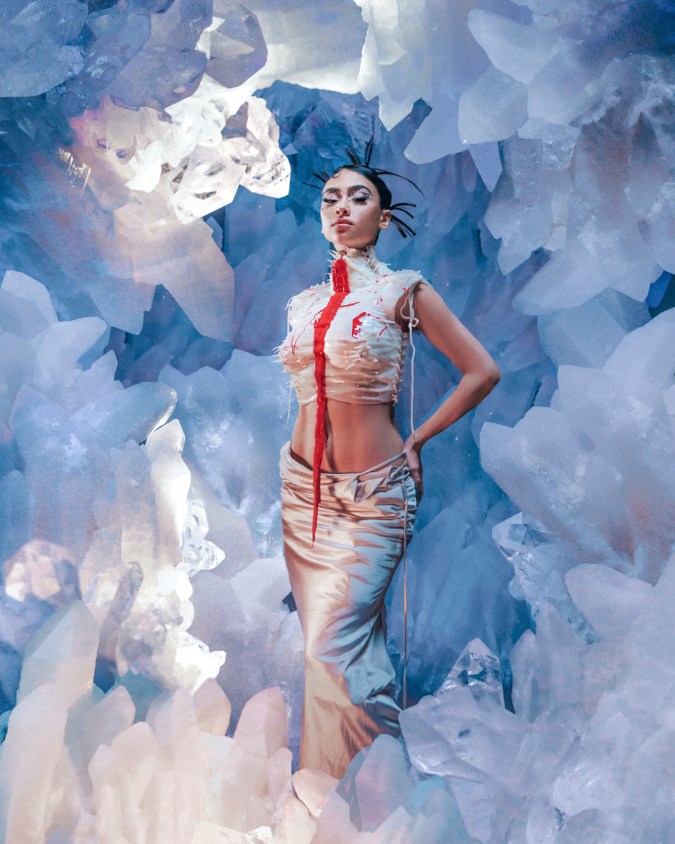The argument that physical LPs are somehow better or more authentic–the warmth of analog instrumentation, the liner notes or vinyl album pull-outs–is a subjective one. But it’s also stale and stubborn, and neglects the fact that digital expression is also a valid artform, and can be as special as any vinyl album. Beyoncé’s Lemonade as a film and Solange’s revival of the long-standing social networking site Black Planet alongside her visual album When I Get Home are especially memorable, and against those landmark albums, both of which feel dynamic and lifelike despite the (incorrectly) presumed flatness of their digital deliveries, pitting streamed music against its physical predecessors seems purposeless.
Paloma Mami’s debut full-length, Sueños de Dalí, comes with a litany of trappings, and while it’s not as earth-shattering as Lemonade, it’s an innovative example of modern-day rollout excellence. Through a multi-faceted delivery, the Chilean-American singer-songwriter evokes a curiosity of analyzation and a need to explore the work from start to finish, again and again, and with all its appended elements at the ready.

A few days prior to the March 19 release, Paloma Mami revealed on socials a busy visual pastiche of an album cover, presumably inspired by the iconic surrealist painter for which the album’s named. The scene depicted includes big-eyed girls, like a hybrid of Bratz dolls and Margaret Keane’s signature style, in various presentations: a two-headed bodybuilder, a girl draped in giant gold chains, another painted totally bien-triste-blue and donning an oversize broken-heart sweater. In the background there’s a girl in a transparent box positioned as if pushing to get out. Another girl’s heart is bursting out of her chest. There’s also a boy in a water tank, and an alien too. Paloma Mami is centered among them, on a painted dove but collaged into the mix with photographic realness. It all might seem random–but maybe it’s not.
That Paloma Mami frames this album as artwork is likely because she’s a painter herself; her work is often on the clothing she wears. She loves theater too, and with the entire rollout of Sueños de Dalí, she’s given us drama.

The album’s brief intro, “Mi Palomita,” is transportative. A crackling sound like an old record player leads us into Paloma Mami’s Dalí-tinged world where, like the paintings, multiple closer, intentional analyses are a must for attempting a full understanding. Is total comprehension even possible, though? Isn’t that subjective? The feather-light, vocal-centric ends abruptly, like a reel that’s run out of tape. There’s no empty space for us to ponder. But we can linger on the imagery attached to the track: It’s titled “Flight,” and is one of three visuals created for specific tracks by portrait artist Rosie Hardy. In this one, a winged Paloma Mami ascends among doves from a cavernous place and into a celestial light.
While the subject matter of some songs is undoubtedly culled from events in and around her own life, the lyrics are not wholly personal; Paloma Mami’s songwriting is more like storytelling. “For Ya,” about one-sided romantic devotion, was co-written with her partner, Roa. Convincing as she is stepping into character along the suave, sedated reggaeton rhythm, she’s not talking about their relationship, but interpreting the experiences of people.
It’s interesting, too, how these already-released singles don’t elicit a skip-over, but instead flow comfortably with the greater album. Along with “Goteo” and “Mami,” two other not-so-new hits, these tracks feel fresh all over again in this new, surrealist context. Now the digital drip-drop accents of “Goteo” bring us to the virtual realm of its video without having to have seen it, and the high notes of “Mami” feel almost extraterrestrial.
“Religiosa” brings back the nostalgic crackle before entering another slow-sway-paced reggaeton backdrop over which Paloma Mami wraps her vocals like a snake, with unexpected twists and dips of diction.
An interlude it may be, but “Dreams” is a memorable mid-album moment, quiet yet intensely affecting: “You feel like you’re better than my dreams,” she sings repeatedly, reaching a heavens-high register. Artwork was created for this track, too: Paloma Mami is pictured mid-step on a staircase that leads to a kind of dimensional portal.
Trap influences are sprinkled throughout Sueños de Dalí, but there’s a three-track run that’s especially tinged with trap by beats and trills. On “RDMDA,” “I Love Her,” and “Traumada,” Paloma Mami’s vocals are like the unpredictable growth of ivy, meandering yet mesmerizing in how perfectly they weave in and around the rhythm. (Side note: Don’t be surprised as lesbians and other women who love women snatch up “I Love Her” like it was written just for them. I already have. And Hardy’s artwork, in which an empowered-looking Paloma Mami is centered around crystalline ice, can easily translate to emphasize this.)
“Que Wea” ends this dream with something of a summary of Paloma Mami’s career dreams. Recalling her early clapback-to-haters cut, “Don’t Talk About Me,” this one we can safely assume is personal. As if with a smirk, she sings, “Sé qué me ven bien y no lo soportan/ Ay, dios / Si supieran qué no vo’a fallar.”

In Paloma Mami’s extensive, well-considered rollout, there’s also a clothing line: A collab with Bershka was unveiled the same day Sueños de Dalí was released. The fashions mirror the dystopian futurism of right now that’s advanced by the album’s visuals. A video for “Traumada” came out the same day as well and it, too, feels like some kind of parallel dimension that’s occurring at this very moment.
Sueños de Dalí nods to the avant-garde, hints at unknown universes and dimensions. Or maybe it’s all a dream sequence? Paloma Mami doesn’t have to ask us to examine deeply all she’s proffered with this work; it’s all intriguing enough that we’ll want to bring intentionality to our digesting of this album.
Probably this will manifest as us our earbuds in and phones at hand, rather than a replica of the oft-used image of a listener sprawled out on a carpeted floor, listening to a record with its paraphernalia strewn about. Still, we’ll probably have a ton of windows open, we’ll be looking at imagery on Spotify, we’ll be on her Instagram looking for more information–and isn’t that basically the same thing?




